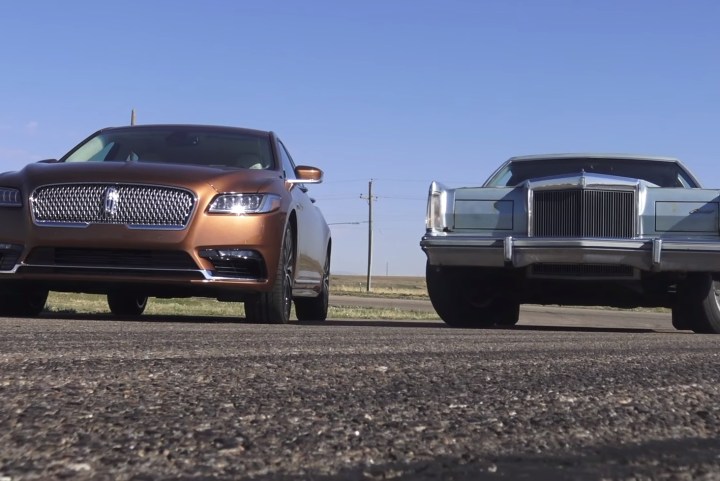
Youtube channel The Fast Lane Car was curious, so it put a pair of Continentals side-by-side on the starting line of an impromptu drag race. Spoiler alert: it turns out there is a replacement for displacement after all.
The massive, naturally-aspirated V8 in the Carter-era Continental makes just 210 horsepower — no joke. To put that figure into perspective, it’s about what you can expect today from a garden-variety turbocharged 2.0-liter four-cylinder. Meanwhile, the modern-day Continental used in the race is equipped with a twin-turbocharged 3.0-liter V6, which is part of Ford’s EcoBoost family. It delivers 400 horsepower in this application, making it the Conti’s most powerful engine option.
You’re thinking “horsepower sells cars but torque wins races,” right? The 1978 boasts 357 pound-feet of torque, while the 2017’s EcoBoost belts out 400 pound-feet. And yet, torque alone isn’t enough to help this rolling behemoth win the race and take home the bragging rights.
The modern Continental takes the lead right away and stays there until it reaches the finish line, propelled by the fury of two turbochargers relentlessly shoving boost into the cylinders. The original model crosses the finish line approximately five seconds later in the most lackadaisical manner imaginable. It doesn’t help that the latest Continental shifts through a six-speed automatic transmission with relatively short gear ratios dialed in to improve acceleration. Backing up the V8 in the 1978 car is a three-speed automatic; acceleration and fuel economy be damned!
Of course, it’s important to point out performance specifications are relative. In 1978, a 210-horsepower V8 was one mighty impressive engine. especially when it was installed in the engine bay of a personal luxury coupe. Besides, no one has ever purchased a land yacht-era Continental thinking they’d beat a Corvette in a race. Then and now, the Continental has always been about luxury and style.
Editors' Recommendations
- Goliath car screens have arrived, and Ford’s new software takes full advantage
- How to watch DJI unveil its new FPV drone live online today
- Lincoln will launch its first electric vehicle with help from Rivian
- Toyota gives its sweet, race-ready Supra the green flag for production
- Scoot wants you to take rides on its new electric moped instead of in a car




